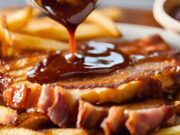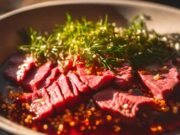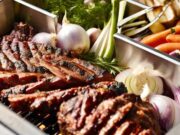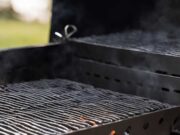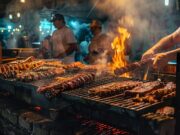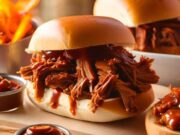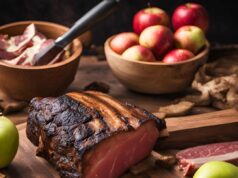When it comes to BBQ grilling, understanding the distinction between direct and indirect heat can significantly elevate your culinary skills and enhance your outdoor cooking experience.
This guide outlines the essentials of both methods, exploring their benefits, key differences, and optimal setups.
Whether you are searing a steak over high heat or slow-roasting a whole chicken, knowing when to employ each technique can truly make a difference.
Explore this guide to master the art of grilling and impress your family and friends.
Key Takeaways:
- Direct heat cooking involves placing food directly over the heat source, resulting in quick and intense cooking.
- Indirect heat cooking involves placing food to the side of the heat source, resulting in slower and more even cooking.
- Understanding the differences between direct and indirect heat helps you choose the right method for different types of food and achieve delicious results on the grill.
What is Direct Heat Cooking?
Direct heat cooking is a grilling method that entails exposing food directly to the flame or heat source. This approach generates high temperatures that create a charred exterior, enhancing flavor through the Maillard reaction.
This technique proves particularly effective for meats such as steaks, burgers, and chicken, which benefit from a sear that seals in juices and adds depth to their flavor. For optimal results, controlling the flame is essential; adjusting air vents or positioning food over different heat zones allows for precise temperature management.
Incorporating marinated vegetables and seafood can further elevate your grilling experience, as their natural sugars caramelize beautifully when exposed to direct heat. Understanding how to master these elements can transform simple grilling into a culinary delight that showcases the vibrancy of fresh ingredients.
The Benefits of Direct Heat When Grilling
Direct heat cooking presents numerous benefits that significantly enhance the grilling experience. It allows you to achieve perfectly seared meat with attractive grill marks, a delightful char flavor, and the capability to cook quickly at high temperatures, making it ideal for popular dishes such as grilled steaks and burgers.
One of the most notable advantages of using direct heat is the rapid cooking process; your food can transition from grill to plate in just a few minutes, facilitating spontaneous gatherings. This method intensifies flavors, as the high temperatures caramelize sugars and develop the signature smokiness that food lovers desire.
Moreover, direct heat is particularly well-suited for thin cuts of meat, poultry, and vegetables, which all benefit from this quick exposure to heat. The high searing temperatures effectively lock in juices, resulting in tender and succulent dishes that elevate even the simplest ingredients into gourmet meals, satisfying the palates of everyone who partakes.

What is Indirect Heat Cooking?
Indirect heat cooking is a grilling method that involves positioning food away from the direct heat source. This allows convection heat to circulate, cooking the food evenly, which is particularly effective for larger cuts like tri-tip roasts and for low-temperature cooking.
This technique is fundamentally different from direct cooking, where food is exposed directly to flames or heat, often resulting in a charred exterior and uneven cooking. With indirect heat, your meal benefits from a gentler cooking process, where the surrounding air transfers warmth to the food, facilitating an even and thorough cook while helping to retain moisture.
Using this method not only enhances the natural flavors but also allows for the infusion of smoky notes, especially when barbecue wood chips are incorporated. Cooking with this approach is ideal for recipes that require longer cooking times, enabling spices and marinades to penetrate deeply into the food, resulting in a richer and more complex flavor profile.
The Benefits of Indirect Heat When Grilling
The benefits of indirect heat cooking include the ability to prepare food safely at lower temperatures, resulting in juicy meats and the development of delicious flavors without the risk of burning. This method is particularly well-suited for grilling chicken, ribs, and even delicate seafood.
By using indirect heat, you not only enhance the taste and texture of various dishes but also minimize the chances of foodborne illnesses, ensuring that your food is cooked thoroughly yet gently. The cooking environment created by this method is more forgiving, allowing you to achieve exceptional results with thicker cuts of meat, such as brisket or pork shoulder, which can benefit from longer cooking times without drying out.
Additionally, vegetables roasted slowly using this technique can caramelize beautifully, leading to an irresistible depth of flavor. Those who adopt this approach often find their meals bursting with taste and safe for consumption.
Comparing Direct and Indirect Heat
When comparing direct and indirect heat cooking, it is essential for you to understand the key differences in their applications. This includes the cooking zones, heat transfer, and the types of grilling techniques that benefit from each method.
These factors ultimately influence the overall grilling experience and outcomes.
Key Differences and When to Use Each Method
Understanding the key differences between direct and indirect cooking methods will help you determine which technique to use based on the cooking time required and the specific type of food you are grilling.
For instance, when preparing smaller or more tender cuts of meat, such as chicken breasts or steaks, direct cooking is often the preferred choice due to its quick cooking times and ability to achieve that desirable char and caramelization on the surface. Conversely, for larger and tougher items like briskets or whole chickens, indirect cooking is the optimal method, allowing the meat to cook slowly and evenly while retaining moisture.
You should also consider the grill temperature; maintaining a steady heat and monitoring cooking times is essential. By effectively utilizing heat zones and keeping an eye on the internal temperature, you can achieve a perfectly grilled masterpiece, whether it’s sizzling on direct heat or developing rich flavors through indirect methods.
Setting Up Your Grill for Both Methods
Setting up your charcoal grill for both direct and indirect cooking methods is straightforward. By creating distinct cooking zones, you can establish a two-zone setup where one side generates intense heat for searing, while the other side maintains lower temperatures suitable for slow cooking.
This technique enables you to optimize your grilling experience and achieve the desired results for various dishes.
Tips for a Two-Zone Setup
A two-zone setup on your grill is an effective method to manage both direct and indirect cooking. This setup allows you to quickly sear meats over direct heat while utilizing the indirect side for slow cooking or keeping food warm.
By mastering this technique, you can significantly elevate your grilling skills. Effective flame control is essential; this involves adjusting the burner settings or repositioning charcoal to create both hot and cooler zones. Monitoring the temperature is equally important, so using thermometers ensures you achieve optimal results.
This method enhances flavor and texture while providing versatility for a variety of grilled dishes, enabling you to prepare perfectly cooked steaks, tender chicken, and even roasted vegetables. Adopting this approach allows you to create restaurant-quality meals right in your backyard, making it suitable for both casual barbecues and special gatherings.
Combining Direct and Indirect Heat
Combining direct and indirect heat cooking techniques can significantly enhance your grilling experience. This approach enables methods such as reverse searing, in which meats are initially cooked using indirect heat and then finished with a high-temperature sear.
This technique results in a juicy and flavorful outcome, ensuring optimal taste and texture for your grilled dishes.
Techniques for Effective BBQ Grilling
Effective BBQ grilling techniques require you to master the balance between direct and indirect heat, understand how to utilize flavor components such as wood smoke, and monitor cooking temperatures to achieve perfectly cooked and flavorful meals.
To elevate your outdoor cooking skills, it is essential to explore the nuances of ingredient selection, including the types of meat, marinades, and rubs that can significantly influence your grilling experience.
Incorporating a variety of hardwoods, such as hickory or mesquite, can impart unique flavors that transform ordinary BBQ into extraordinary dishes.
Utilizing a reliable thermometer is crucial for maintaining ideal cooking temperatures, as it ensures that the meats are not only delicious but also safe to eat.
Grilling techniques, ranging from searing to low-and-slow methods, should be tailored based on your ingredients and personal preferences, allowing for a more customized and enjoyable BBQ experience.
Frequently Asked Questions
What is the difference between direct and indirect heat in BBQ grilling?
Direct heat is when the food is cooked directly over the heat source, while indirect heat is when the food is cooked next to the heat source.
Which meats are best cooked using direct heat?
Thin and tender meats, such as steaks, burgers, and fish, are best cooked using direct heat as it allows for a quick sear and retains the natural juices.
What are the benefits of using indirect heat for BBQ grilling?
Indirect heat is ideal for cooking larger and tougher cuts of meat, such as ribs, brisket, and whole chickens, as it allows for a slower and more even cooking process, resulting in tender and juicy meat.
Can I use both direct and indirect heat in one BBQ grilling session?
Yes, many recipes call for a combination of both direct and indirect heat, known as the two-zone method, to achieve the desired level of doneness and flavor in the food.
How do I set up my grill for indirect heat cooking?
To set up your grill for indirect heat cooking, place charcoal or heat source on one side of the grill, and place the food on the other side. For a gas grill, turn off the burners on one side and place the food on the other side.
What is the best way to control the temperature when using indirect heat?
For charcoal grills, use a drip pan filled with water underneath the food to help regulate the temperature. For gas grills, adjust the burners to control the heat. Using a thermometer can also help monitor the temperature and ensure your food is cooking at the desired level.








